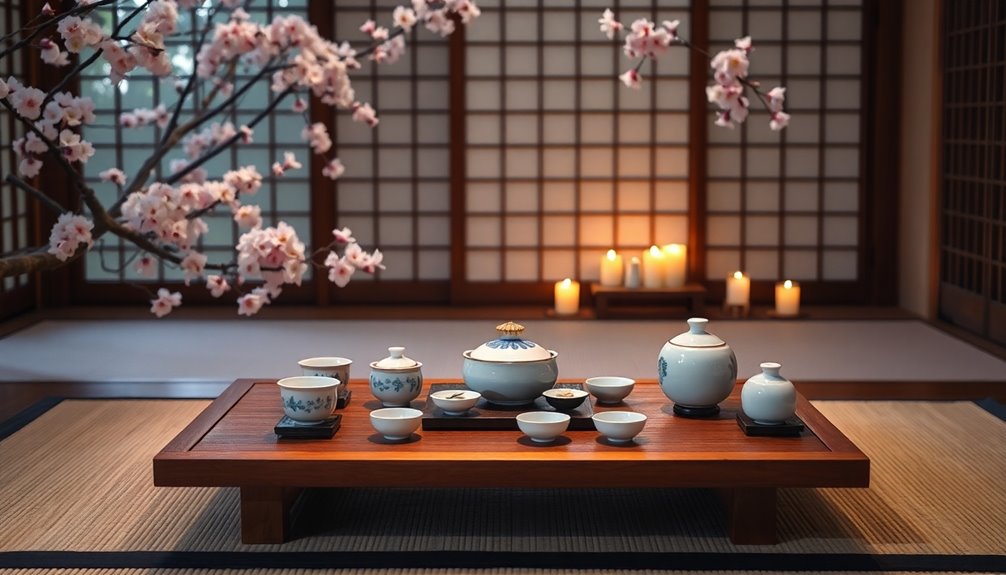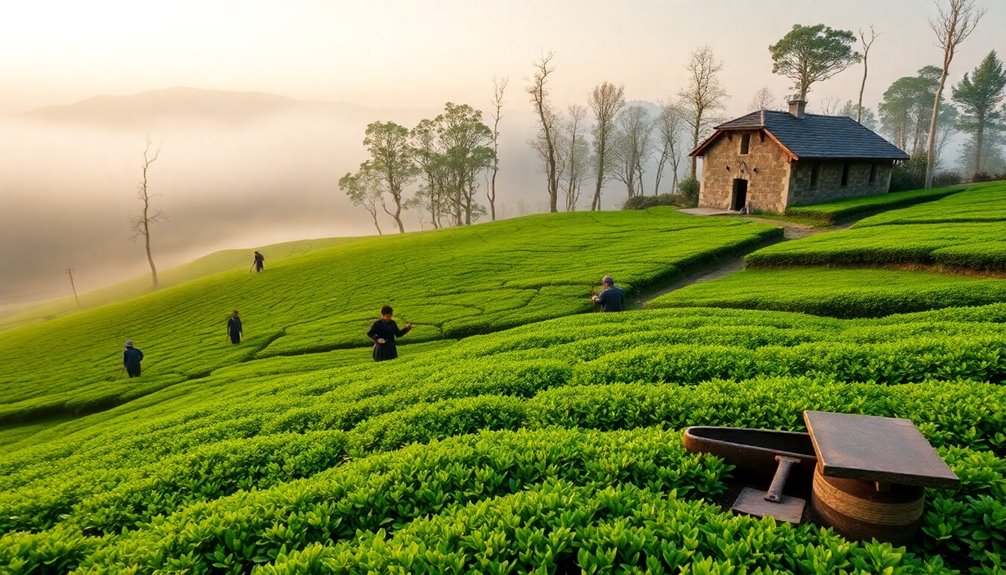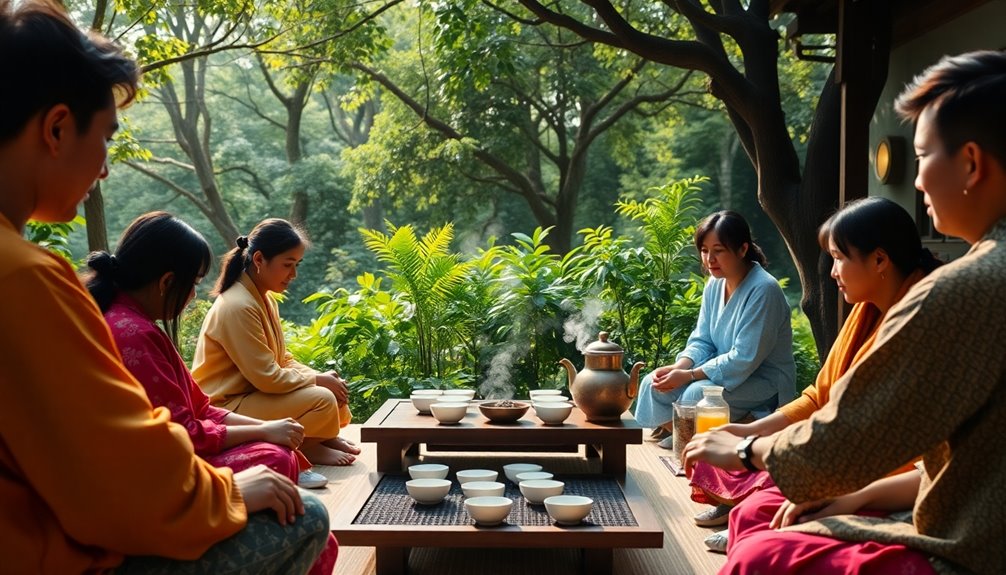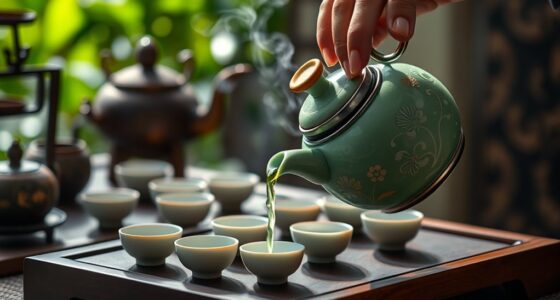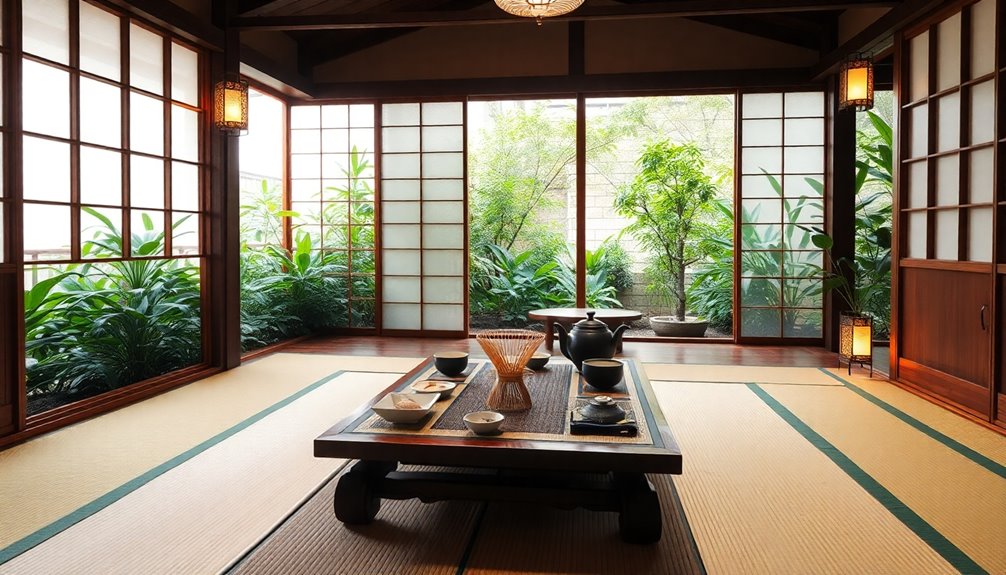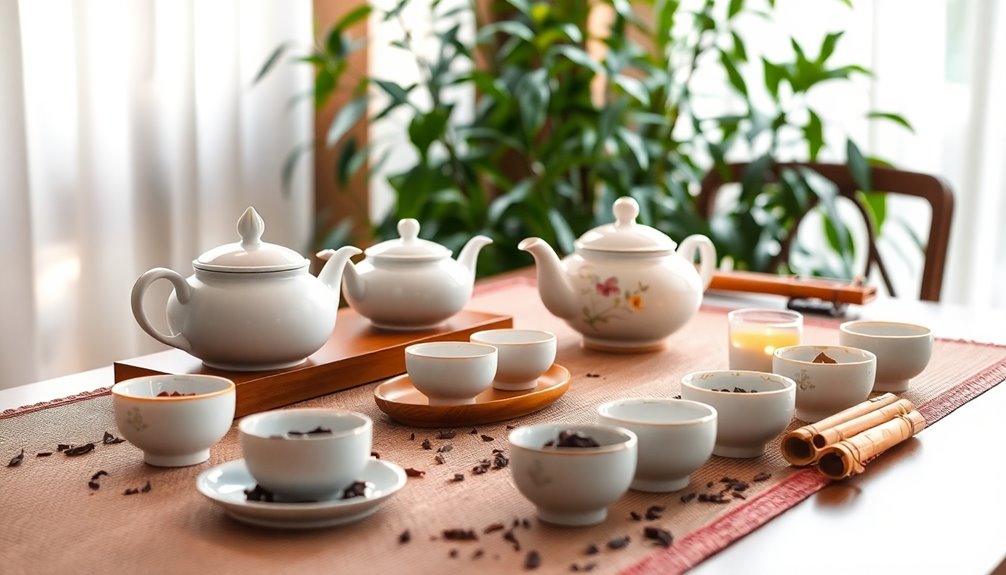To host your own traditional tea ceremony, start by creating a clean, peaceful space. Gather essential utensils like a chawan (tea bowl), chashaku (bamboo scoop), and chasen (whisk). Arrange a simple floral decoration, or chabana, for a touch of beauty. Choose high-quality matcha tea, and prepare fresh water in a mizusashi. Begin by welcoming your guests and explain the significance of the ceremony, emphasizing harmony and mindfulness. As you whisk the matcha, invite everyone to appreciate the moment. This gentle practice can bring joy and connection. If you're curious about more details, stay tuned for further insights!
Key Takeaways
- Prepare a clean and organized space to create a serene environment, essential for a traditional tea ceremony.
- Gather essential utensils: chawan, chashaku, chasen, mizusashi, and chaki or chaire for an authentic experience.
- Incorporate simple chabana floral arrangements to enhance the aesthetic and embody the beauty of simplicity.
- Emphasize the principles of harmony, respect, purity, and tranquility throughout the ceremony to reflect its cultural significance.
- Engage in mindful practices during the ceremony, fostering presence and appreciation of each moment shared with guests.
Introduction
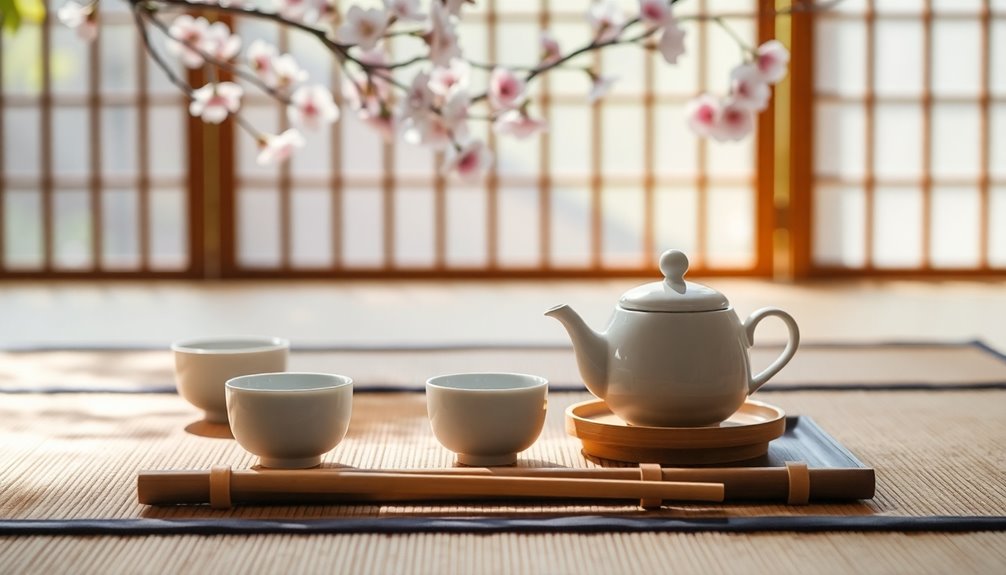
Hosting a tea ceremony can be a truly enriching experience, allowing you to connect with tradition and your guests on a deeper level. A traditional tea ceremony emphasizes harmony, respect, purity, and tranquility.
To create a serene environment, start by choosing a clean and organized space. Simple floral arrangements, known as chabana, will enhance the atmosphere and encourage mindfulness during the tea experience.
You'll need essential tea utensils, including a chawan (tea bowl), chashaku (bamboo scoop), and chasen (bamboo whisk). Make sure to use quality matcha or loose-leaf tea, as these contribute to the authenticity of the ceremony.
Depending on your occasion, you can choose between Chaji, a more formal event often including a meal, or Chakai, an informal gathering with lighter refreshments.
Understanding guest etiquette is also crucial. Teach your guests how to serve and receive tea respectfully, which enriches the experience and fosters deeper connections.
Cultural Significance of Tea Ceremonies
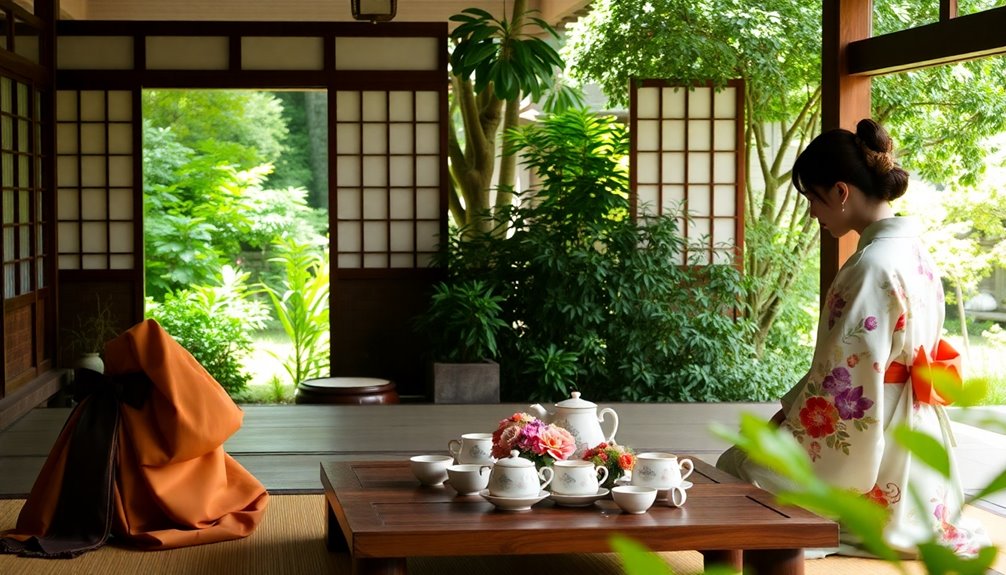
Tea ceremonies hold profound cultural significance, reflecting deep-rooted values that resonate throughout Japanese society. At the heart of these ceremonies are four principles: Wa (harmony), Kei (respect), Sei (purity), and Jaku (tranquility). These concepts promote mindfulness and an appreciation of nature, making each ceremony a special occasion.
Originating from Zen Buddhist traditions, the tea ceremony is more than just making tea; it's a meditative practice. You'll find joy in the ceremonial preparation, where every detail matters, from the quality of the matcha to the elegance of the teaware. This attention to simplicity and beauty, inspired by historical figures like Sen no Rikyū, highlights the charm of imperfection.
Each gathering is unique, embodying the spirit of "ichigo-ichie," which means cherishing each moment and encounter. As you host your own tea ceremony, remember that it's not just about the tea; it's about creating a peaceful atmosphere where everyone can connect.
Embrace these principles, and you'll create a memorable experience that reflects the rich cultural heritage of Japan. Enjoy the process, and let the beauty of the ceremony unfold naturally!
Essential Utensils for Tea Ceremony
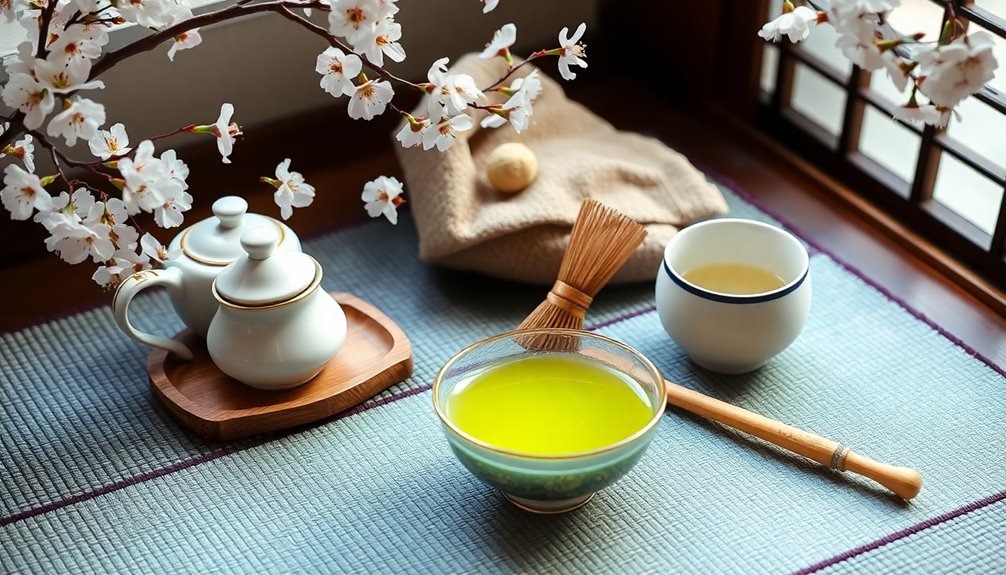
What essential tools do you need to create an authentic tea ceremony experience? First, you'll need a Chawan, the beautiful tea bowl that holds your matcha. It's wide enough for whisking and often showcases seasonal aesthetics.
Next, grab a Chashaku, a bamboo tea scoop. This handy tool helps you measure out the perfect amount of powdered matcha for your brew.
To mix that matcha to perfection, you'll rely on a Chasen, a specialized bamboo whisk. It's crucial for frothing and achieving the right texture.
Don't forget the Mizusashi, a container for fresh water. It's usually made of ceramic or porcelain and adds a touch of elegance to your setup.
If you want to store your powdered matcha, consider using a Chaki or Chaire. These containers not only keep your matcha fresh but also reflect seasonal themes, enhancing the overall experience.
With these quality tea utensils, you're all set for ceremonial preparation. Each tool plays a role in ensuring your tea ceremony is both authentic and enjoyable.
Tea's Role in Mindfulness Practice
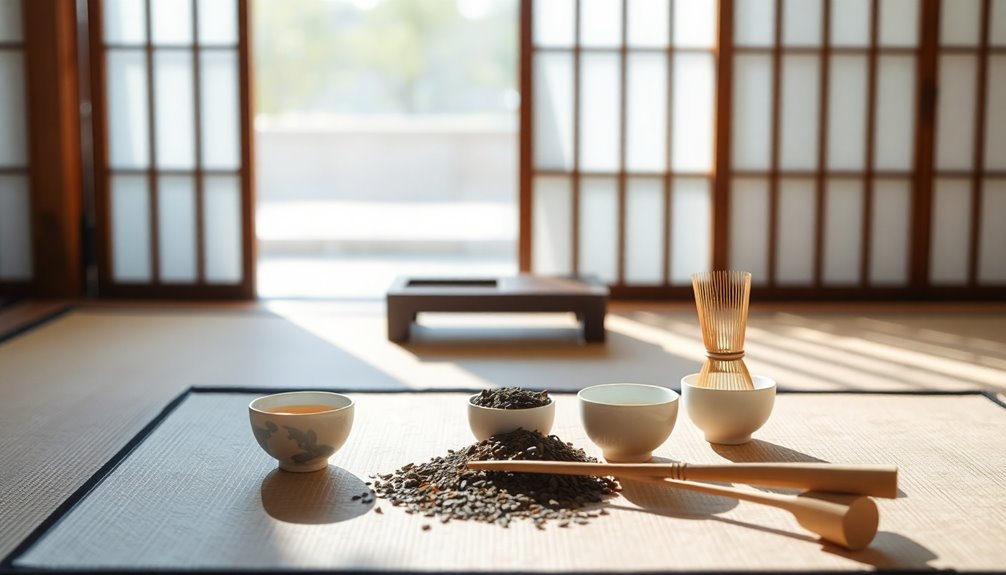
Creating an authentic tea ceremony isn't just about the tools you use; it's also about the experience you cultivate. The traditional Japanese tea ceremony serves as a beautiful form of moving meditation. It allows you to practice mindfulness through intentional actions and focused engagement with the tea preparation process.
During the ceremony, silence and stillness help you foster a unified mindset, promoting your presence and awareness. You can let thoughts and feelings pass without judgment, which creates a purifying space for your mind. Engaging with the sensory aspects of tea—like its aroma, taste, and texture—enhances your mindfulness, encouraging a deeper appreciation of the moment.
As you practice this ceremony regularly, you may notice a reduction in symptoms of anxiety and depression. This can lead to improved emotional well-being and mental clarity.
The principles of harmony, respect, purity, and tranquility intrinsic to the tea ceremony align perfectly with mindfulness practices. Remember, it's all about being fully engaged in the present experience.
Cultural Appropriation Debates
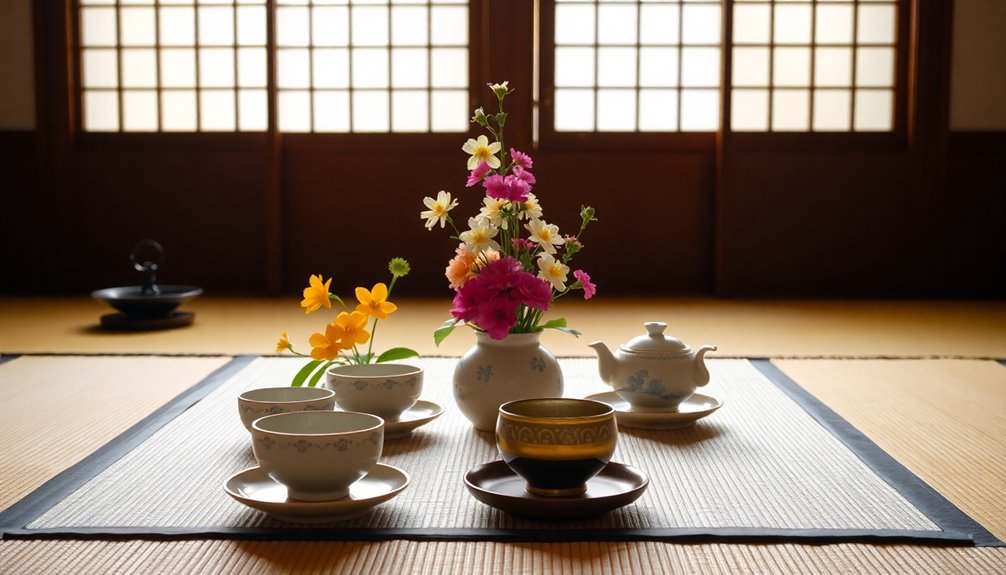
While enjoying the beauty of a tea ceremony, you might also encounter discussions around cultural appropriation, particularly concerning the significance of these traditions.
Cultural appropriation happens when elements of Japanese culture, like tea ceremonies, are adopted without understanding their history and meaning. Critics often argue that when people commercialize tea ceremonies, it can dilute their importance and create stereotypes.
To engage respectfully, think about cultural exchange instead. This means recognizing the origins and practices of tea ceremonies, rather than just using them for profit.
It's essential to understand the significance of each element in the ceremony, from the tea master's role to the ceremonial preparation. Engaging with tea ceremonies should involve learning from cultural practitioners who can share their knowledge and values.
Practical Applications
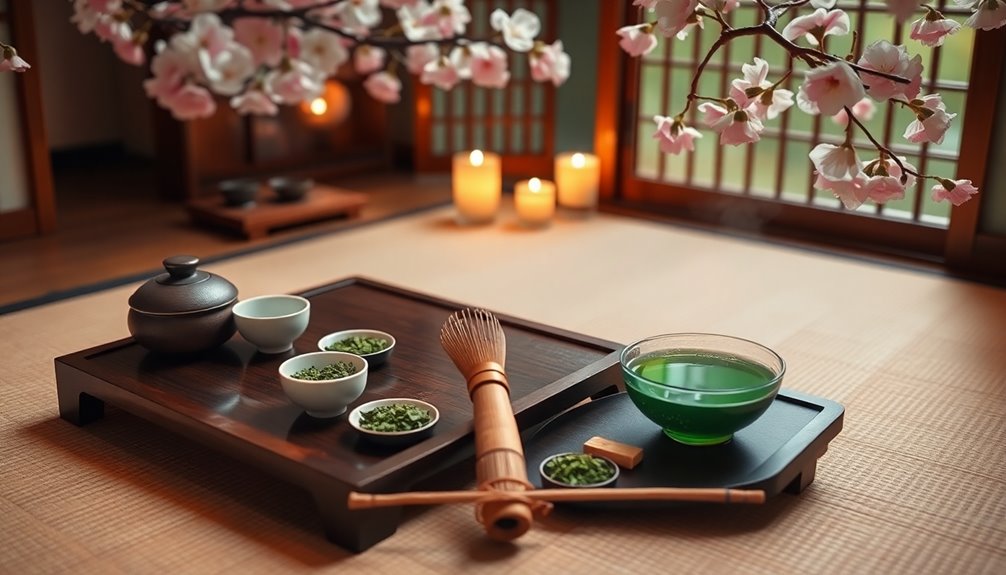
To host a successful tea ceremony, you'll want to gather essential utensils like a tea bowl (chawan), bamboo tea scoop (chashaku), whisk (chasen), and a water container (mizusashi) for preparing matcha or loose-leaf tea.
These traditional utensils are key to creating the perfect tea experience.
Next, focus on creating a serene atmosphere. Choose a quiet space, clean it thoroughly, and add seasonal flowers (chabana) and hanging scrolls (kakemono).
These elements enhance the beauty of your tea ceremony and invite mindfulness.
Before serving, perform a purification ritual to set a respectful tone.
Master the whisking motion to prepare frothy matcha, and don't forget to serve traditional snacks (wagashi) that balance the flavors.
Using seasonal varieties reflects the cultural significance of the ceremony.
Frequently Asked Questions
How to Have a Traditional Tea Ceremony?
To have a traditional tea ceremony, find a serene space, gather essential utensils, and prepare the tea mindfully. Serve it with appreciation, encouraging gentle conversation, and conclude by inviting guests to share their thoughts on the experience.
Who Pays for the Tea Ceremony?
When it comes to who pays for the tea ceremony, you typically cover the costs as the host. However, guests might bring small gifts or contribute, helping balance the financial aspects of the gathering.
What Are the Four Principles of the Tea Ceremony?
The four principles of the tea ceremony are Wa (Harmony), Kei (Respect), Sei (Purity), and Jaku (Tranquility). Each principle helps you cultivate mindfulness and appreciation during the ceremony, enhancing your overall experience.
How to Start a Tea Ritual?
To start a tea ritual, gather your utensils, create a calming space, and select high-quality matcha. Measure, warm your bowl, and whisk mindfully, focusing on the flavors and sensations as you enjoy each sip.
Conclusion
Hosting your own traditional tea ceremony can be a delightful experience! By gathering the right utensils and understanding the cultural significance, you'll create a special moment for you and your guests. Remember, it's not just about drinking tea; it's about enjoying mindfulness and connection. As you share this beautiful tradition, be aware of its roots to respect its origins. So, brew your tea, embrace the ritual, and let the calming atmosphere bring joy to everyone involved!

